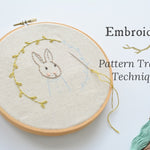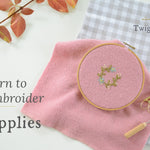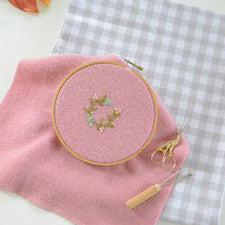Making felted soap is one of my favourite wooly crafts to do with children. A small project that works well for little hands, my daughter is always delighted at the transformation of fluffy wool roving into solid felt. With a bit of help, this project is suitable for young children, but is entirely appealing for older children and adults too!
With such lovely colours and texture, felted soap is both beautiful and practical, and makes a perfect gift for friends and family.

Making felted soap is a perfect introduction to the art of wet felting. The elements are simple: wool, soap, hot water, and agitation. But the transformation of the fibres as they bind together into a solid fabric is quite magical. As fibres shift and adhere, the results may not always be predictable, but the final product is so lovely.
Materials
- Wool roving
- Bars of soap
- Old nylon stockings (optional, but much easier for children)
- Hot water
- Towels

A note about the materials...
The bars of soap don't have to look pretty, because they'll be covered in wool. I've sometimes been able to buy "seconds" from a local soap maker - the soap may have may have flaws, but is perfect for felting.
Wool roving is wool that has been processed and carded so that all the fibres are running parallel, preparing the fibre for spinning or felting. Roving is available in a wide array of inspiring colours that can be used for wet or needle felting.
The types of wool most commonly used for felting are merino and corriedale. Based on personal experience, I would say that corriedale is generally a more robust wool - a bit more coarse, but it doesn't have to be handled with as light a hand as merino. Merino roving is lovely, soft, and well-suited to wet felting, but I do find that it needs to be handled more delicately. For felting with children, I would recommend starting with corriedale.
Setting up
Be sure to cover your work surface with towels, as things will get rather drippy and wet once the felting starts.
Prepare a bowl of hot water (as hot as you can stand putting your hands into) and keep a kettle of hot water close by for topping up the bowl of water.
Cut the foot off of the nylon stocking. Once wrapped in wool, the soap will be put into the toe of the stocking, then knotted.
Felting Soap
Step 1:
Begin with a length of roving to wrap around the bar of soap. Pull off enough roving to wrap around the soap 2-3 times (when separating a length of roving, always be sure to gently pull it apart rather than cutting).
Pull the roving out a bit wider than the soap and flatten it out before wrapping.

Wrap the soap so that it is well covered and there are no thin spots. Ensure that it gets wrapped longways as well (with the layers of fibre running perpendicular to one another) so that the ends are covered.

If desired, add wisps of different colours. Note that the decorative elements are unlikely to stay exactly where you have placed them. There's always a bit of an unknown element with wet felting - it's all part of the magic of the process. Here's a wrapped soap that is ready to felt:

Step 2:
If desired, carefully put the wool-wrapped soap inside the toe of the nylon stocking, then tie a knot to hold it in place. While not completely necessary, the stocking makes the process much easier for children and beginners.

Step 3:
Dip the soap into the bowl of hot water to wet the wool. Begin by rubbing the soap gently so that the wool doesn't get dislodged while the felting process starts. Every so often, dip the soap into the hot water again. It will take several minutes for the wool to start felting.

Step 4:
Once the wool has begun to felt, it can be agitated more vigorously. Be sure to rub all parts, including the ends. When the wool has felted and feels quite firm, remove the soap from the stocking to check on its progress. It may require a bit more friction to finish up, but at this point it's not really necessary to put it back in the stocking - it's fine to just rub the wool directly.

Step 5:
When the wool has finished felting, give it a good rinse under cold water to finish it off. Pat the felted soap with a towel to remove excess water and admire your beautiful handiwork!


I hope you've enjoyed learning a bit about wet felting and how to make felted soap. It really is such a simple and satisfying craft - I hope you're inspired to give it a try!
My daughter and I so enjoyed doing this activity together - working with wool is one of her favourite craft activities (I think she may get that from her mama...). She is so proud of making these, and she now has some beautiful felted soap that she can gift to friends and family.


We'd love to see what you make, so please join us in the Twig + Tale Facebook Group, a friendly place to ask questions, look for inspiration, and share photos of your projects!




